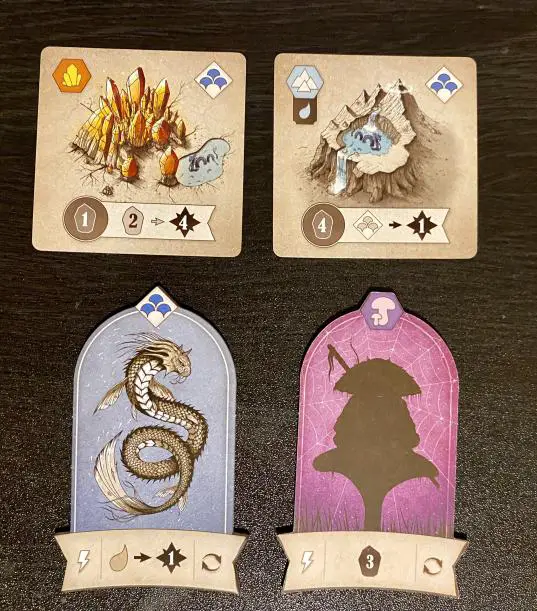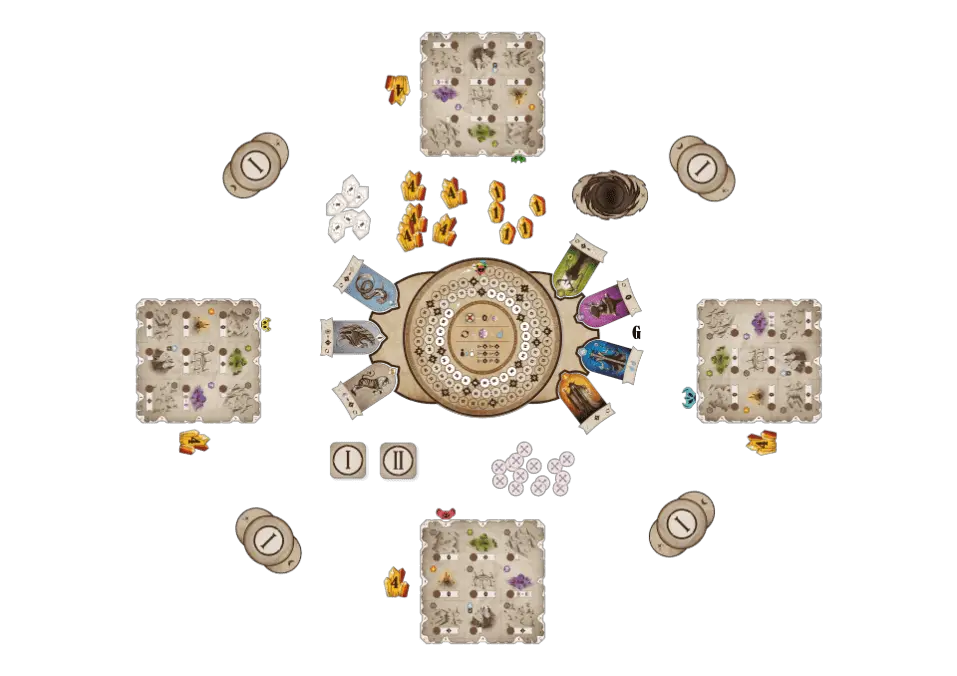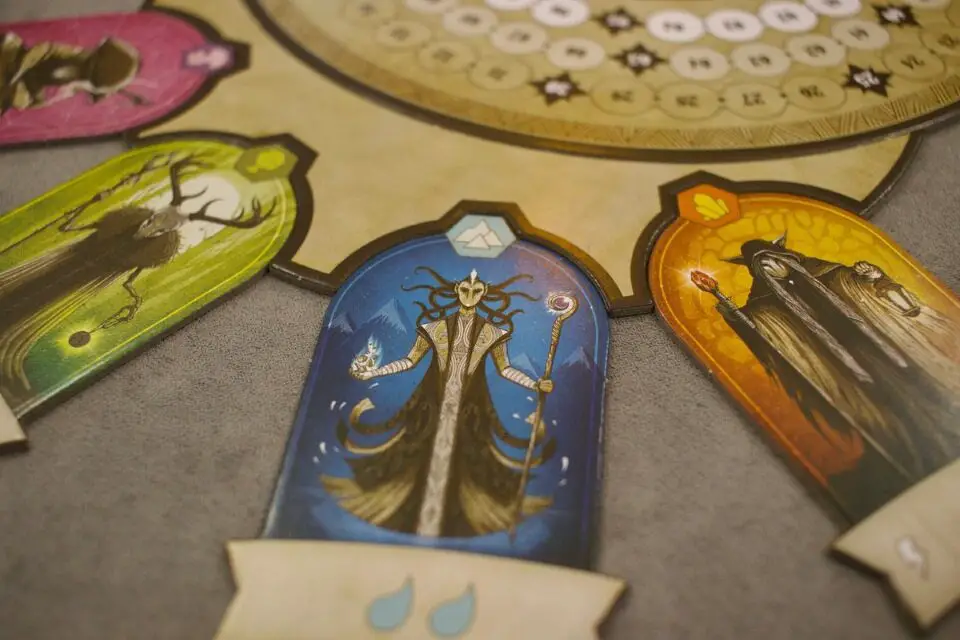Sometimes you wakeup and realize that you’re a Shaman who is now in charge of one of the five worlds and you’ve got divine powers. It happens. Rauha , a game by French design studio GRRRE Games is now available via Hachette Board Games in English and sees players competing to obtain the most victory points over the course of two Ages while strategizing to develop the best biomes!
What’s in the box?
Rauha comes with five individual player boards, a central scoring board and game aid, two side modules that hold the seven divine entity tiles, 45 spore tokens, 40 Age I and 40 Age II biome cards, five energy tokens, five avatars, 37 crystals of value 1 and 15 crystals of value 4, one black hole board, five satellite boards, and six +100 tokens for use in scoring, and the game rules.
I really love the graphics and design in Rauha. Each player board has nine squares for biomes, and they all have illustrations on them to signify the type of biome. It’s very fairytale/fantasy-esque, which fits for the theme of a world with shamans and divine entities, and the avatars were good, but I was sad that the crystals were just cardboard. That would have been a cool place to have something a bit more substantial and pretty.
The biome cards for Age I show vegetation, terrain, and wildlife. The biome cards for Age II add civilizations. However, not all biomes that have water as part of the illustrations actually have the water symbol. This design seems like an odd choice when the rest of the biome cards had art that clearly indicated what exists in those biomes! I would have much preferred to see other art on the cards if they don’t actually contain a water source.


For example, the crystal biome (in the second image) has a lake with a water dragon inside, but no water symbol. The mountain biome next to it, however, has a water source as shown by the mountain and waterfalls. Of course the lake is a closed formation, but you can get water from it…
Biome cards include one of five symbols for the forest, mountain, crystal, mushroom, and desert biomes. The left circle shows the cost (crystals, free to play with constraints, or free with no constraints) to place a biome. The circle also holds Spores that you receive from either discarding a biome or spending crystals. Finally, the biome effect is next to the circle, and there are sometimes one of three animal symbols (flying, land, and marine).
I especially enjoyed the double-sided design for the divine entities. The entities have a detailed art side and a dark side to help keep track of during scoring as you flip them from detailed to dark.
How’s It Play?
Setup was pretty easy, as shown below. Each player gets a board, avatar, and corresponding energy tokens. The satellite boards are setup so that the moon is on the left and the star faces the right and are placed between players with four biome cards placed on each satellite.

Rauha takes place over four rounds, each with three turns, followed by a scoring phase. Each turn, you will follow five steps. Players simultaneously take the biome from the satellite whose symbol matches the one beneath your Avatar on the player board (moon or star). You then one at a time take three actions.
First you choose one card to place on any square of your player board or discard to the Black Hole (for a Spore or four crystals), receive a Divine Entity if you create a row or column of matching symbols on the board, and activate your avatar or any Divine entities in the same row or column as that avatar. Finally, you both simultaneously move the avatar one notch clockwise along the edge of the player board. Your energy token is always on the scoring board in the middle.
During the Scoring Phase, you activate all your Biomes with Spore tokens and any Divine Entities that you may have, gaining crystals and points as shown on the components. There are seven Divine Entities with names like Metsat, Disciple of the Forest who provides one Life Energy point per matching animal on your board that you choose. There’s also Sienet, the Disciple of Mushrooms who gives you three crystals during each scoring phase, and Kiteet, Disciple of Crystals, who gets you three Life Energy points. One more Disciple is of the Hills and Water, while the three Elders are of the Skies, Earth, and the Seas.
Rauha‘s nine Biome effects all either provide more crystals, life energy points, or you can spend a certain number of crystals to gain more spores to place on the board. Each round requires four new biome cards, with round three and four using cards from Age II.
The Verdict?
To be completely honest, Rauha‘s rule book, which is really just four pages and one double-sided sheet, doesn’t make any sense the way that it’s set up. The single sheet seems like it was meant to be a reference sheet (which I love, always give me a reference card or sheet please), but the parts on the sheet should be in the main rulebook!
For example the description of the biomes and board description should go first after components and setup. On the first few plays we kept getting confused about the directions and how the game worked because we kept flipping to where we would expect pieces and not finding them. I think putting those pieces in the rulebook proper and putting the game turn overview on its own card would have been more helpful. Obviously now that we know how the game works, it’s not a big deal, but I always want games to be easy entry for players of all kinds!
As for theme, Rauha‘s entire premise is about being a shaman who is now in charge of the world and trying to get the Divine Entities support. But I don’t know squat about the world, and don’t really know anything about the Divine Entities who are all so lovely to look at, either. It would have been much more immersive to have a page or two all about the world’s lore and who these entities are that we’re supposed to care about.

Also it’s a fantastical world, so are the animals like real life because if we’ve got water monster dragons, what else do we have? This lack of immersion made me sad because it’s a game about being shamans that isn’t super racist! I was so excited! Give me that backstory!
Playing Rauha once we knew what was going on was amazing though. My friend and I were competing like no other and really strategized in attempts to get the most points. One frustrating or amazing part of the game depending on the player is that you can take the divine entity from another player if you get three in a row too, which means that you’re not always going to be smiled upon by them!
Of course, this immediately happened to me and then I got absolutely demolished in the points because my friend managed to get Vuori, the water dude (maybe he’s not a dude, I don’t know, because I have no lore), who gives you two water sources to whatever you have on the board each time you score. The more water you have than any other player, the more life points you have. At one point my friend got 15 points. You can’t beat that, which made me even more competitive and we had a grand time once we got going.
I think it would be interesting to extend the game too by adding more rounds to the game so you can see how many biomes you end up stacking (since you can put one on top of another). It’s a really entertaining experience and very quick to set up which is always a pro in my book.
You can grab Rauha from Amazon, your FLGS, and Hachette directly for $45.
Images and review copy courtesy of Hachette
Have strong thoughts about this piece you need to share? Or maybe there’s something else on your mind you’re wanting to talk about with fellow Fandomentals? Head on over to our Community server to join in the conversation!

